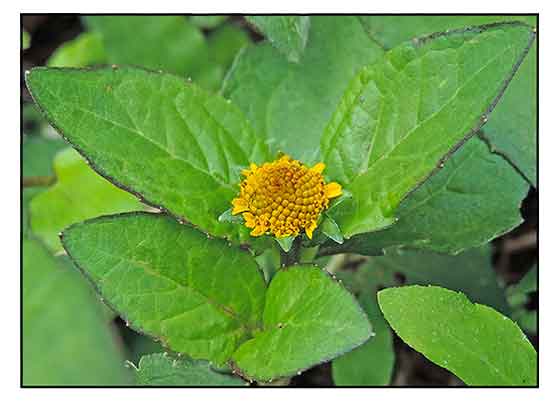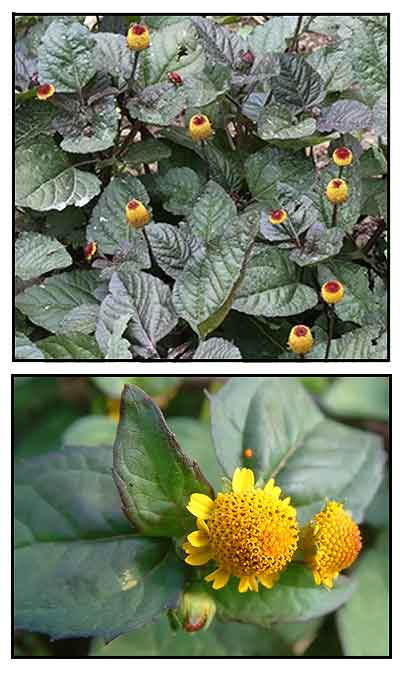Gen info
- Acmella is a genus of plants in the family Asteraceae. It was described as a genus in 1807.
- Acmella paniculata and A. oleracea share the common name "toothache plant".
 Botany Botany
• Growth form: Perennial herb up to 0.8 m tall. Foliage: Leaves are egg- or lance-shaped with a toothed leaf margin and rough surface on both sides. Flowers: Tiny, yellow flowers known as disc florets are arranged in a round to cone-shaped inflorescence. The inflorescence emerges from the leaf axils (the attachment point of the leaf to the stem). Fruit: The dry, one-seeded fruit is known as an achene. (Flora & Fauna Web)
Note: Acmella paniculata looks very similar to Acmella oleracea. The former has smaller leaves and flower, with leaves 2-4 cm long, ovate-lanceolate to ovate; heads 8.4 -12.5 mm tall. Acmella oleracea leaves are broadly ovate to deltate, 5-10 cm long; heads 10.5-23.5 mm tall. (Flora & Fauna Web)
• Herbs, annual. Stems branched, erect or ascending, to 30 cm or more tall, rarely rooting at nodes. Petiole 1-2 cm; leaf blade ovate to ovate-lanceolate, 2-4 × 1-2.5 cm, 3-veined, base cuneate, margin entire or coarsely or crenately serrate, apex acute. Capitula discoid, solitary, terminal or axillary, 8.4-12.5 × 6.9-10 mm; peduncles 2.5-16 cm, sparsely pilose; phyllaries 9-12, 2-seriate, ovate-lanceolate, ca. 6 mm, herbaceous, glabrous; receptacle 5-8 × 1.1-3 mm, apex acuminate. Florets 90-200; corollas tubular, minute, 4- or 5-lobed. Achenes obovoid, 3-angled, ca. 3 mm, margin scabrid, apex slightly depressed; pappus of 2 subequal bristles, longer one 0.5-1.1 mm, shorter one 0.4-0.9 mm. Fl. Apr-Nov. 2n = 26. (Flora of China)
 Distribution
Distribution
- Native to the
Philippines.
- Also native to Assam, Bangladesh, Borneo, Cambodia, China South-Central, China Southeast, India, Jawa, Laccadive Is., Laos, Malaya, Myanmar, Nepal, Queensland, Sri Lanka, Sumatera, Taiwan, Thailand, Vietnam. (1)
- In fields, wastelands, roadsides, forest margins; 800-1900 m.
Constituents
- Phytochemical screening of petroleum ether (PE), chloroform (C), ethyl acetate (EA) and methanol (M) extracts yielded flavonoids (PE, EA, M), alkaloids (all), tannins (PE, M), saponins, with absence of phenolic, amino acids, carbohydrates, proteins, and anthra-cyanosides. (see study below) (5)
-
GC-Ms analysis for volatile oil components in stems, leaves, and flowers yielded a total of 91 volatile components with 55, 58, and 49 kinds, respectively, quite different in various parts.
- Phytochemical analysis of flowers revealed presence of tannins, saponins, reducing sugars, alkaloids, flavonoids, terpenoids, and phenolic compounds.
(13)
Properties
- Studies have suggested antibacterial, anthelmintic, anti-inflammatory, antiarthritic, antidiabetic, neurodegerative-attenuating, insecticidal properties.
Parts used
Leaves, flowers.
Uses
Edibility
- Tender leaves and young shoots are edible; cooked and eaten as a potherb.
- Seeds used in pickles and curries.
Folkloric
- No reported folkloric medicinal use in the Philippines.
-
Cone-shaped inflorescence used to treat toothache and throat and gum infections. For toothache, fresh or dried flowers are chewed to deaden pain. Leaves used for bacterial and fungal skin diseases and wounds, as as protection from colds and flu.
- Whole plant used for treatment of dysentery. Paste made from plants applied to snake bites. Juice from flower heads drunk to relief stomach pains. Pungent flower heads chewed to relieve toothache and other mouth-related ailments. Leaves externally applied on skin diseases. Root decoction drunk as purgative. (16)
Studies
• Antimicrobial: Study evaluated various plant extracts (pet ether, chloroform, ethyl acetate, and methanol) of A. paniculata for antimicrobial activity against 12 strains of microorganisms using agar dilution method. Results showed antibacterial activity against more than one pathogen. The chloroform, pet ether and methanol extracts completely inhibited the growth of Enterobactum aeruginosa. (see constituents above) (5)
• Anthelmintic: Study evaluated the anthelmintic activity of various extracts of A. paniculata using adult Indian earthworm Pheretima posthuma model. Preliminary phytochemical screening revealed presence of alkaloids, saponins, flavonoids, and tannins. Three concentrations of 0.075, 0.15, and 0.22 w/v of each extract were used in measures of time of paralysis and time of death. The petroleum ether, ethyl acetate, chloroform and methanol extracts showed remarkable anthelmintic potential. (6)
• Antibacterial / Leaf, Shoot, Root, Flower: Study evaluated the antibacterial activity of aqueous extract of different parts of A. paniculata by agar diffusion method against some pathogenic bacteria viz., Bacillus subtilis, Escherichia coli, Salmonella typhi, Staphylococcus aureus, Vibrio cholerae, and Vibrio parahemolyticus. Roots showed moderate activity against the tested pathogen. The Vibrio species were the most resistant strains. Flower and leaf extract showed ZOIs of 27 and 24 mm against Salmonella typhi. (7)
• Anti-Inflammatory / Antiarthritic / Flowers: Study evaluated the potential anti-inflammatory and antiarthritic effects of A. paniculata flowers through in silico and in vivo approaches. In vivo study assessing anti-inflammatory and antiarthritic potential in carrageenan-induced paw edema a and complete Freund's adjuvant (CFA)-induced arthritis model suggested significant reductions in paw volume, arthritis score and inflammatory markers (CRP, RF, IL-6, and TNFα and improved histopatho-logical outcomes extract and fraction treated Wistar rats. Ferulic acid, isoferulic acid, and acetyl aleuritolic acid were identified as bioactives that targeted RELA, a key NF-kB component. Results highlight the anti-inflammatory and antiarthritic potential of A. paniculata via multi-protein modulation, particularly NF-kB signaling, and suggest therapeutic potential for rheumatoid arthritis. (8)
• Anti-Inflammatory / Antiarthritic / Antihyperglycemic / Flowers: Study evaluated a hydroethanolic extract of Acmella paniculata flower (HEFeAP). Anti-inflammatory activity, protective role against RA, and anti-hyperglycemic activities evaluated via egg-albumin denaturation, MTT assay against human-fibroblast cells and α-amylase inhibition showed IC50s of 27.61, 65.75, and 85.43 µg/mL, respectively. TNF-α and nitric oxide (NO) levels were significantly down-regulated in LPS-stimulated PBMC-derived macrophages (IC50 152 and 164.56 µg/mL). Phytochemical screening revealed coumarins, flavonoids, polyphenols, steroids, and local-anesthetic alkylamides. Active phytomolecules exhibited strong binding with inflammatory markers. Results suggest potential for inflammatory pain, RA, and diabetes. (9)
• A. paniculata and Cissus quadrangularis Rectal Suppository for Acute Hemorrhoids: Cissus quadrangularis is used for treatment of hemorrhoids and Acmella paniculata is a medicinal plant with local anesthetic effect. Study evaluated the potential of rectal suppositories containing CQ and AP extracts to alleviate symptoms of hemorrhoids compared with commercial rectal suppositories containing hydrocortisone and cinchocaine. Results showed comparable effects on bleeding, prolapse size, and anal pain. In terms of safety, commercial suppository group experienced higher levels of adverse events, like anal pain and bleeding. CQ and AP combined extract suppositories showed potential in alleviating hemorrhoidal symptoms with a good safety profile. (10)
• A. paniculata and Cissus quadrangularis Rectal Suppository for Acute Hemorrhoids: Study evaluated the potential of spilanthol, a major bioactive metabolite isolated from Acmella paniculata, in attenuating neurodegenerative diseases (NDD) through a multi-faceted approach. In silico pharmaco-kinetic and toxicity screening of spilanthol indicated favorable characteristics for oral delivery, blood-brain-barrier permeability, and minimal toxicity. Network phamacology predicts spilanthol attenuates neuroinflammation in NDDs by suppressing toll-like receptor signaling pathway. In vitro testing using BV-2 microglial cells showed potential of spilanthol in reducing the production of proinflammatory cytokines and mediators such as NO, TNFα, and IL-6 induced by polysaccharide. Results suggest spilanthol mitigates neurodegeneration by alleviating neuroinflammation. (11)
• Anti-Streptococcus mutans / Flowers: Streptococcus mutans is a common bacterium that initiates dental caries at an early stage. Study evaluated the mode of action of A. paniculata extracts against S. mutans growth. Results showed AP flower n-hexane and dichloromethane extracts acted as bactericidal agents after killing >3 log10cfu/mL of S. mutans after 24 hours. Oleic and hexadecenoic acids were the major components in the extracts, respectively. Scanning and transmission electron microscopy showed lysis of bacterial cell wall and decrease in cytoplasm content. Pathway analysis showed the extract affected biosynthesis peptidoglycan, gene expression, RNA processing, and macromolecule metabolism processes in S. mutans. Data analysis revealed multiple mechanisms in the antibacterial activity of AP toward S. mutans. (12)
• Insecticidal Against Fall Armyworm / Spodoptera frugiperda / Leaf and Flower: The fall armyworm, Spodoptera frugiperda, is a polyphagous crop pest in Indonesia. Study evaluated the bioactivity of insecticide compounds in A. paniculata against S. frugiperda. The leaf extract revealed isoamyl acetate (56.45%) and 4-vinylguaiacol (16.64%), while the flower extract revealed amyl propionate (17.22%), 4-vinylguaiacol (16.64%) and deanol (24.50%). Results showed the leaf and flower extract exhibited conspicuous toxic effects and antifeedant on 3rd instar larvae of S. frugiperda. The flower extract showed showed highest larvae mortality, compared to the leaf extract. Larvae mortality ranged from 72% to 92% when exposed to high test concentration of 13% flower extract, with LC50 and LC90 of 6.236% and 10.945%, respectiively. This may be attributable to 4-vinylguaicol, the major chemical compound identified in the flower extract. The flower extract, besides affected mortality of larvae, also had a negative effect of the weight of the larvae and antifeedant rate. (14)
• Antibacterial Fungal Endophytes: Study characterized fungal endophytes isolated from Acmella paniculata for antimicrobial activity. A total of 171 isolates of endophytic fungi assigned to 10 represen-tative morphotypes, including six genera i.e., Aspergillus, Trichoderma, Curvularia, Diaporthe, Penicillum, and Fusarium, with three Mycelia forms from leaves, stems, and roots. Antimicrobial activity was evaluated using agar disc diffusion method against Gm(-) E. coli and P. aeruginosa and Gm(+) B. subtilis and S. aureus with ZOI range of 7.0 to 19.4 mm. Among tested fungal strain endophytic fungi isolated, Penicillum sp. from the leaves exhibited the strongest antimicrobial activity against E. coli with ZOI of 19.3 mm. Results suggest potential for exploitation as sources of novel natural antimicrobial products. (15)
Availability
- Wild-crafted.
- Plants, supplements in the cybermarket.
|

![]()



 Botany
Botany Distribution
Distribution